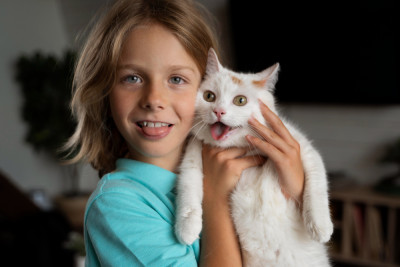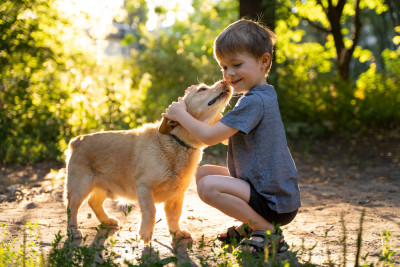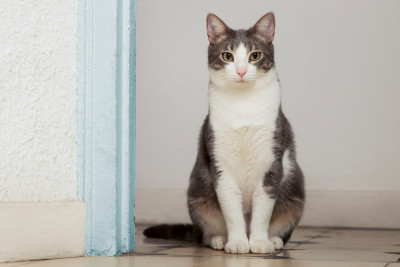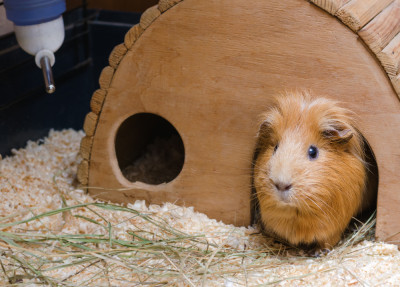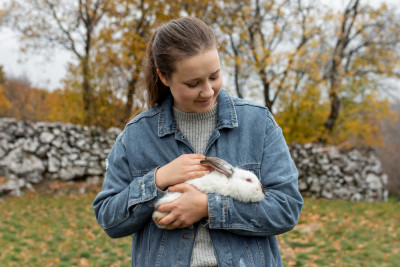Understanding Cats and Kids
Before diving into the tips, let's take a moment to understand the perspectives of both cats and children in this dynamic:
Cats: Cats are known for their independence and sometimes aloof behavior, but they can also be incredibly affectionate and patient. Cats may be initially wary of new, unpredictable small humans, and their reactions can range from curiosity to caution.
Children: Children are naturally curious and often enthusiastic about pets. They may want to play with cats, hug them tightly, or chase after them, but they may not fully understand a cat's boundaries or cues.
With this understanding in mind, let's explore the tips for a harmonious household where cats and kids can thrive together.
1. Teach Children About Cat Behavior
Educating children about cat behavior is essential. Explain that cats have unique ways of communicating, such as purring when content and hissing when upset. Teach them to recognize signs of stress in cats, like flattened ears or a twitching tail, so they know when to give the cat space.
2. Supervised Interactions
Always supervise interactions between young children and cats. Even the most patient cat may react negatively if a child accidentally pulls its tail or startles it. Supervision ensures both the child's safety and the cat's comfort.
3. Gentle Touch and Respect for Boundaries
Teach children the importance of gentle touch and respecting a cat's boundaries. Show them how to stroke a cat gently and avoid sudden movements. Make it clear that when a cat retreats or shows signs of discomfort, they should give the cat space.
4. Provide Safe Spaces for Cats
Cats need a safe retreat where they can escape from the hustle and bustle of family life. Ensure that your cat has access to a quiet space where they can relax and recharge without disturbance from children or other pets.
5. Regular Exercise and Playtime
Active play is essential for both cats and children. Encourage children to engage in interactive play sessions with the cat, using toys like feather wands or laser pointers. This helps burn off excess energy and fosters positive interactions.
6. Set Up Cat-Friendly Zones
Create cat-friendly zones in your home, such as cozy corners with cat beds, scratching posts, and toys. These areas can serve as safe spaces for your cat and encourage them to spend time with the family.
7. Teach Responsible Pet Care
Instill a sense of responsibility in children by involving them in pet care tasks, like feeding and grooming (under supervision). This helps children understand the commitment and effort required to care for a pet.
8. Encourage Calm and Quiet
Teach children to be calm and quiet around the cat, especially when the cat is eating or resting. Explain that sudden loud noises or disruptions can stress the cat.
9. Positive Reinforcement
Reward children for positive interactions with the cat. Praise them when they handle the cat gently or engage in interactive play without overwhelming the cat.
10. Timeouts for Cats
If the cat becomes agitated or overwhelmed, it's essential to give them a timeout in their safe space. Explain to children that the cat needs a break and will come back when ready.
11. Respect Feeding Times
Teach children not to disturb the cat during meal times. Explain that cats are creatures of routine and need their meals in peace.
12. Involve Children in Training
As children grow, involve them in positive reinforcement training for the cat. This can be a fun and educational way for kids to interact with their feline companion while teaching the cat new tricks or behaviors.
13. Regular Vet Checkups
Emphasize the importance of regular vet checkups and health care for the cat. Involving children in these trips can foster a sense of responsibility and empathy.
14. Lead by Example
Children often learn by observing their parents or caregivers. Set a positive example of how to interact with and care for the cat, and children are likely to follow suit.
Conclusion
A harmonious household with both cats and kids is achievable with patience, education, and respect for both species' needs. By teaching children about cat behavior, supervising interactions, and encouraging responsible pet care, you can create a loving and safe environment where cats and kids can thrive together. Remember that each cat and child is unique, so adapt these tips to suit your specific family dynamics, and enjoy the special bond that can develop between your feline and human family members.

